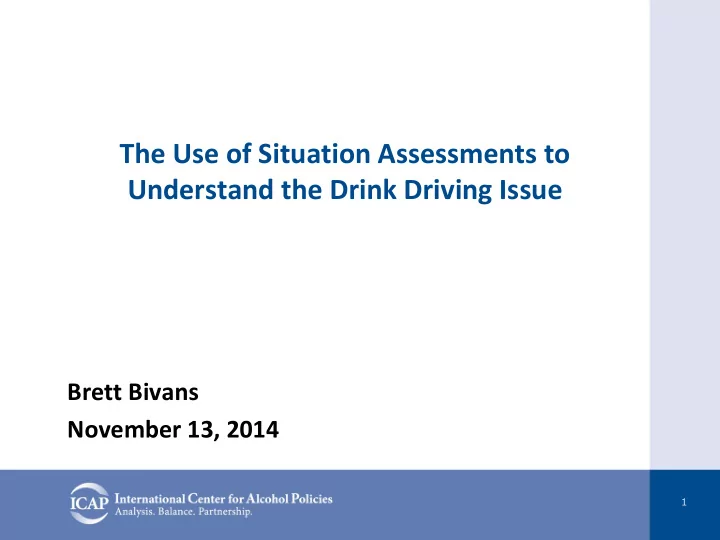

The Use of Situation Assessments to Understand the Drink Driving Issue Brett Bivans November 13, 2014 1
Why Assess the Situation? Important to conduct a situation assessment before implementing a program to prevent alcohol related crashes. Three main reasons: To identify the scale of the problem To understand the currently available mechanisms in place To provide baseline data for monitoring and evaluation 2
Overview of a Situation Assessment • Comprehensive document profiling everything about the problem • Used to guide program development • Identifies information gaps • Records past experience • Points toward program objectives • Points toward program design • Points toward program evaluation 3
Developing a Situation Assessment Others ’ Experience Crash Data Legislation Collect, collate, and analyze Undertake a literature search Identify licensing laws, crash and injury data on drink driving programs and drink driving laws, etc. initiatives Agency Roles Drink Drivers Identify agency responsibilities Identify drink driver target for liquor licensing, driver groups and their motivations licensing, vehicle registration, for drink driving (commission road safety, law enforcement, qualitative research, if this Situation Assessment road infrastructure, healthcare, information is unavailable) Total Problem Profile etc. Drinking Profile Community/Driver Views Identify where and when alcohol is consumed to excess Identify community/driver views (map locations, times, and about drink driving drinking venues) Past Programs Draft Program Stakeholders Analyze past drink driving Identify possible objectives, Identify Stakeholders and their programs used by others potential components, and likely interest in drink driving (program content, activities, likely evaluation objectives for approaches, and planning the future drink driving experience) intervention 4
Information Interpretation • Key components must be analyzed • Use a simple question sheet • Use a yes/no response process • Map the gaps or things not known • Build a picture of the things known • Build a picture of improvements needed 5
Crash Data Interpretation Question Do we What to do? know? How many crashes and injuries from Yes Maintain/improve data road accidents? How many crashes and injuries No Law exists, but full data not available, so need a involving illegal alcohol? system to collect data Where and when do alcohol related No Include location and times of crashes in agreed data crashes occur? collection system What types of drivers are most likely Yes Local surveys have identified but data system does to be involved in alcohol related not. Include age, gender, driving experience in crashes? agreed data system. 6
Legislation Interpretation Question Do we What to do? know? Is drink driving illegal? Yes No action needed Is the definition measurable? No Law must be based on blood/breath data not subjective judgments Do police have powers to stop drivers No Include random stopping for breath testing in randomly and ask them to take a draft legislation test? Is there a law requiring drivers who Yes Link illegal alcohol law to crashed driver data have crashed to provide breath when law is passed. or blood alcohol readings Is there a legal minimum drinking age Yes Assess effectiveness law? 7
Community Views Question Do we What to do? know? Do people think alcohol consumption is a Yes Check proportion and strength of factor in road crashes? view What level of alcohol consumption do people No Check views of levels in survey think increases crash risk? Do people agree with police having random No Negotiate with legislators. Consider a stopping powers? publicity campaign on value of random stopping What proportion of people knows the Yes If small proportion need to tell them, if large proportion we don ’ t. penalties for being caught drink driving? Do people believe there is a high chance of No Build increased enforcement levels being caught if they are drink driving? into a program 8
Situation Assessment Guidelines • Developed by ICAP in 2010 • Used to conduct situation assessments in 6 countries • China • Colombia • Mexico • Nigeria • Russia • Vietnam • Assessments conducted by local consultancies 9
Much diversity . . . But. . . some common issues • Lack of accurate official statistics • Lack of public awareness/concern about drink driving • Lack of legal framework, e.g., illegal BAC limit • Lack of enforcement resources: training, equipment • Lack of alcohol control policies • Availability of unregulated alcohol • Cultural acceptance of alcohol use • Lack of norms about drinking and driving 10
Published summaries of the situation assessment process and results: China Colombia Nigeria Vietnam Traffic Injury Prevention: Vol. 13, No 2, March - April, 2012 11
Summary • Situation assessment is the first step • Collect and collate information • Analyze and interpret the information • Use simple check sheets and questions 12
Thank you. Questions? 13
Recommend
More recommend